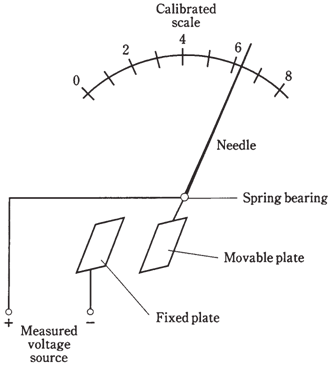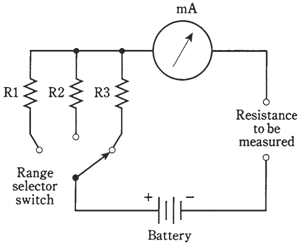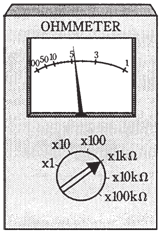Ohmmeters
The current through a circuit depends on resistance. This principle can be used to manufacture the voltmeter by making use of ammeter and a resistor. Larger the value of the resistance in series with the meter, the more voltage is required to produce the reading of full scale.
An ohmmeter is always constructed by means of the milliammeter or microammeter in series with set of fixed, switchable resistances and the battery which provides a known, constant voltage. By selecting resistances appropriately, the meter will provide indications in ohms over the desired range. Usually, zero on meter is given the value of infinity ohms, means a ideal insulator. The full-scale value is set at some specific minimum, like 1Ω,100Ω,or10KΩ.
Ohmmeters should be precalibrated at factory where they are made. A slight error in values of series resistors can create gigantic errors in the measured resistance. Thus, precise tolerances are required for these resistors. It is required that the battery be of exactly the right kind, and that it be fresh so that it will provide

Figure Simplified drawing of an electrostatic voltmeter.

Figure--Circuit for using a milliammeter to measure resistance.
the suitable voltage. The smallest deviation from required voltage can create a big error in meter indication.
The scale of an ohmmeter is nonlinear. This means that, the graduations are not same everywhere. Values tend to be squashed together towards infinity end of scale.
It can be difficult to interpolate for high values of resistance, unless the right scale is selected. Engineers and technicians connect an ohmmeter in the circuit with the meter set for highest resistance range 1st; then they switch the range until the me- ter is in a part of the scale that is easy to read. Finally, reading is taken, and is multiplied by the suitable amount as indicated on the range switch. Figure
shows the reading of ohmmeter. The meter says 4.7, but the range switch says 1 KΩ. This indicates the resistance of 4.7 KΩ, or 4700 Ω.

Figure An example of an ohmeter reading. This device shows about 4.7*1K = 4.7 K=4700 ohms.
Ohmmeters will provide inaccurate readings if there is a voltage between the points where meter is linked. This is because such a voltage adds to, or subtracts from, ohmmeter battery voltage. This changes the battery voltage, and the meter reading is thrown way off. At times the meter might even read "more than infinity" ohms; the needle will hit pin at the left end of scale. Thus, when using an ohmmeter to measure resistance, you should to be sure that there is no voltage between points under test. The best method to do this is to switch off the equipment in question.